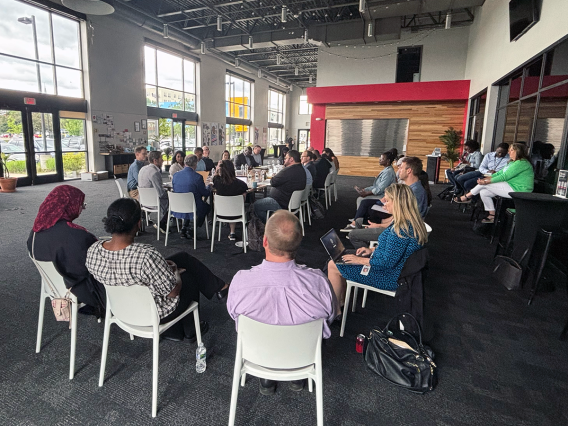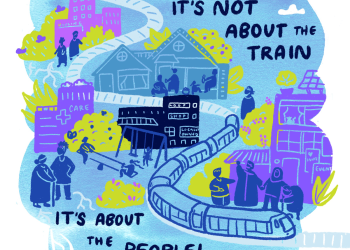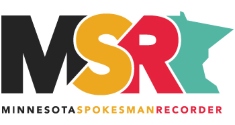
- Also, CURA’s support of anti-displacement work receives the 2024 Kingsley Impact Award
- And other legislative and policy news from 2024
Housing advocates and place-based community organizations are celebrating a $10 initial million investment from the Minnesota State Legislature in funding the new Anti-Displacement Community Prosperity Program. The new program’s goal is to ensure residents and small businesses along the new Blue Line Extension are not displaced from their homes and businesses before, during, or after construction.
The Center for Urban and Regional Affairs (CURA) at the University of Minnesota was contracted by Hennepin County to organize and lead the Anti-Displacement Work Group (ADWG) in February 2022. CURA employed its Reparative Justice Framework and Organizing Philosophy, ensuring stakeholders were treated with dignity and given agency in decision-making.
Last year the ADWG wrote a report recommending anti-displacement strategies around the construction of the Blue Line Extension. This year, representatives of the ADWG went to the legislature and pushed for financial investment into the development of the Anti-Displacement Community Prosperity Program.
“This work matters because the Blue Line Corridor communities have made it quite clear that they don't want this light rail line unless they benefit from it. And they won't be pushed out. This is a tangible step to realizing that outcome,” said C Terrence Anderson, CURA’s Director of Community Based Programs.
Anderson also noted that the ADWG and newly-formed prosperity program are groundbreaking. Governments, from federal to local, recognize that transportation projects are crucial to historically marginalized communities, but have also been harmful in the past.
Additionally, CURA was recently awarded the G. Thomas Kingsley Impact Award for 2024 for its anti-displacement work. The award committee “felt that CURA’s work with the Blue Line Anti-Displacement Work Group was an exceptional example of what it looks like to authentically co-create with community. [The award committee was] impressed by [CURA’s] efforts to build a unified vision across a diverse set of stakeholders and to build the capacity of community members to use information to advocate for their priorities.”
The ADWG was made up of 27 stakeholders, including residents, business owners, philanthropic organizations, government agencies, and more. The Blue Line Extension Anti-Displacement Recommendations report includes 17 policy recommendations crafted by the ADWG after a series of day-long workshops where the group engaged with with CURA's research, community feedback, and members' individual insights to define a cohesive vision for anti-displacement and the desired outcomes for corridor residents, businesses, and neighborhoods.
“I think it's important to know that we celebrate the fact that Hennepin County, the Metropolitan Council, and the corridor cities, are recognizing when we build transit projects in our neighborhoods, that communities of color, Black, and immigrant communities, get disproportionately impacted by development pressures. Anti-displacement work points us to a way of building things differently,” said Ricardo Perez, Blue Line Coalition Lead Organizer with the Alliance for Metropolitan Stability.
Perez also noted that the work group has been community-led and because the prosperity program will be focused on implementing recommendations from that community-led board, work will continue to be community-focused.
The bill, which passed as part of a larger omnibus bill, notes that the work of the community prosperity program is to “preserve and enhance affordable housing, small business support, job training and placement, and economic vitality and to benefit the people and sense of community along the Blue Line light rail transit extension corridor.” The legislation expires the program on June 30, 2030.
The community prosperity program will be made up of 15 members. The bill lays out specifics on what roles and positions those members should represent, as well as specifics on how appointments to the program will be made.
The bill appropriates $10 million for 2024 and $10 million for 2025 from the state’s general fund. From 2026 onwards, the legislation provides an annual base of $10 million. According to a press release from Hennepin County, the work group is expected to find matching funds for their work. The original legislation was authored by Senator Scott Dibble (DFL - District 61) and Rep. Esther Agbaje (DFL - District 59B).
Learn more:
- Read the text of the bill.
- Watch the discussion on the legislation, and testimony including testimony from Anderson, at the April 16 committee of the Senate State and Local Government and Veterans Committee meeting.
- Read the Blue Line Extension Anti-Displacement Recommendations Executive Summary online and the full report can be found here.
- A summary of the work groups’ recommendations can also be found online
- “$10M approved by Legislature for anti-displacement efforts” from Hennepin County
- “It’s About the People: Cocreating Antidisplacement Strategies in the Twin Cities” by NNIP
Other legislative and policy news from 2024:
- C Terrence Anderson, Director of Community Based Programs, testified on behalf of legislation (HF 5075, SF 5191) that would introduce an "Emerald Ash Borer credit" for individual taxpayers, covering fifty percent of the removal cost per tree, with a maximum credit of $1,000. It applies to trees mandated for removal due to emerald ash borer infestation under state or municipal laws. The credit cannot exceed the taxpayer's tax liability and is prorated for nonresident or part-year residents.
- Jeff Matson and the CURA Community GIS program responded to the MN Council on Foundations and Voices for Racial Justice to help with data on precinct-level voter turnout from the 2022 election combined with racial and ethnic demographic data. This data was mapped so groups can more effectively target efforts in areas with low turnout and high percentages of whichever racial or ethnic group their group works with. CURA added data on renters and young voters, other low-turnout groups. The MN Secretary of State’s office wants to share the work with all groups in the state interested in voter outreach. CURA will conduct trainings in summer 2024 as get-out-the-vote efforts ramp up.
Article by Cirien Saadeh









